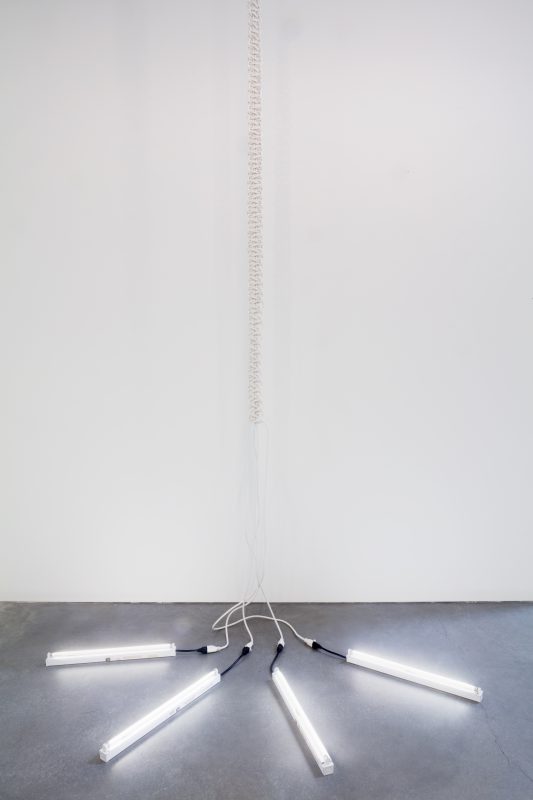Dana Hemenway: All That Glows Sees
Eleanor Harwood Gallery
1275 Minnesota St #206, San Francisco, CA 94107
September 10–October 29, 2016
In her recent work, on view at Eleanor Harwood Gallery in All That Glows Sees, Dana Hemenway is a weaver, an architect, and an excavator. Using utilitarian materials like extension cords, heavy cotton rope, and fluorescent bulbs, Hemenway uses process-based, craft techniques like macramé and ceramics to create objects that oscillate between functionality and decoration.

Dana Hemenway. Untitled (Drywall Weave), 2016; Laser cut drywall, wood, extension cords, custom fixtures, colored compact fluorescent light bulbs; 96 x 108 x 84 inches. Courtesy of the artist and Eleanor Harwood Gallery, San Francisco.
Dominating the center of the gallery is Hemenway’s installation piece Untitled (Drywall Weave) (all works cited 2016). Here, the artist constructed a wall in the center of the gallery, clad in drywall on one side, and with its internal structure revealed on the other. In several places, Hemenway made clean, regular incisions in the wall: sections of squiggled or straight parallel lines then interwoven with brightly colored extension cords, with coordinating compact fluorescent bulbs hanging flaccidly from one end. The artist does not try to conceal the 2x4s stabilizing the wall, peaking through the gaps in her looms, nor does she make any effort to disguise the technical details of the installation, as the brightly colored extension cords lead the eye right to where they are plugged into the electrical sockets running near the bottom of the faux wall.

Dana Hemenway. Untitled (White Macrame Chain), 2016; White extension cords, powerstrip, paint, fluoresent light bulbs; edition 1 of 3; 204 x 48 x 3 inches. Courtesy of the artist and Eleanor Harwood Gallery, San Francisco.
The same is true of two other works of macramé rope and extension cords: Untitled (White Macrame Chain), and Untitled (White Extension Cords, Rope). The former is large wall-mounted object—like an oversized wall sconce—featuring a slab of wood at the top, supporting a row of white compact fluorescent bulbs. Alternating between the bulbs, the artist looped a long, thick white rope through the wood. Following the cord for each bulb down the wall towards a pair of electrical outlet strips, Hemenway weaves the cords around the rope. On the wall directly opposite her work Untitled (White Extension Cords, Rope) formally recalls Felix Gonzalez-Torres’s iconic light string works, like “Untitled” (Last Light), 1993. Here, Hemenway suspends four long white extension cords from the ceiling, entwines their cords, and plugs the four ends into fluorescent tubes laying flat on the ground. The result reads as a fallen chandelier, illuminating just the floor and not the room around it. In all, Hemenway’s sculptures are not quite fixture, and any such aesthetic is undermined by the industrial, everyday nature of her materials.

Dana Hemenway. Untitled (White Extension Cords, Rope), 2016; cotton rope, white extension cords, wood, compact fluorescent light bulbs, zip ties, power strips, paint; 77 x 48 x 3.5 inches. Courtesy of the artist and Eleanor Harwood Gallery, San Francisco.
Hemenway takes the title of her exhibition from Bachelard’s 1958 The Poetics of Space. Bachelard takes a phenomenological approach to the buildings we inhabit, considering emotional and personal responses to everyday architecture and spaces: cellars, attics, and corners. Hemenway builds on Bachelard’s methodology, creating objects that make us reconsider everyday, functional materials in an art context.



